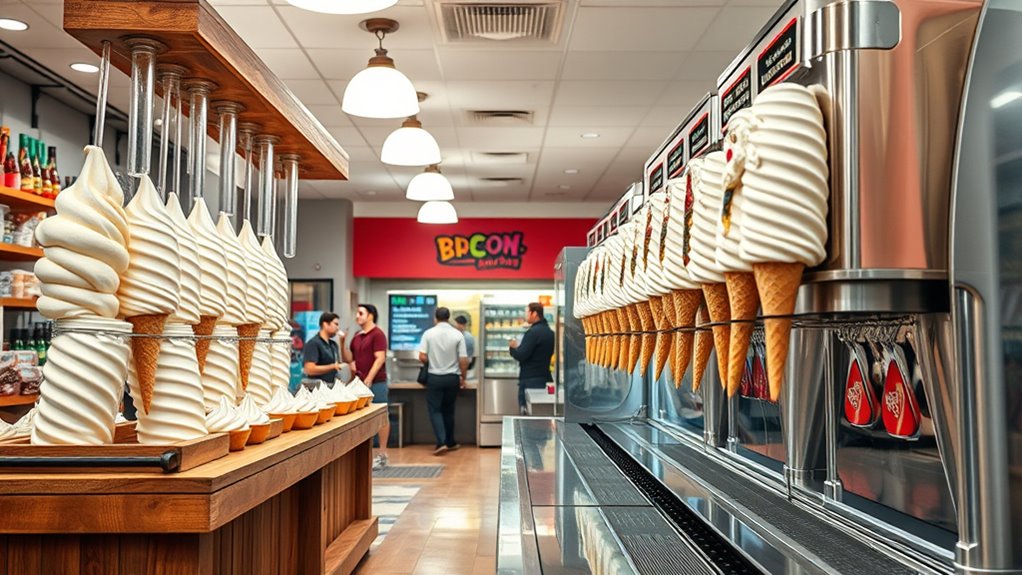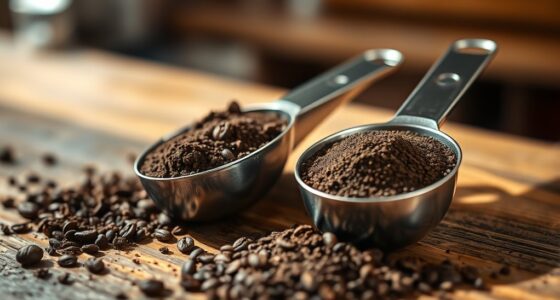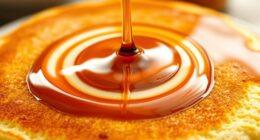Choosing between gravity-fed and pressurized soft serve machines really depends on your business goals. Gravity-fed systems offer consistent flavor and lower maintenance costs, helping you keep customers happy and profits steady over time. Pressurized machines can increase your volume quickly but may require more upkeep and risk flavor variation. To maximize your earning potential, consider which system aligns with your volume needs and maintenance capacity—there’s more to discover if you keep exploring.
Key Takeaways
- Gravity-fed machines often have lower maintenance costs, reducing operational expenses and increasing profit margins over time.
- Pressurized systems can handle higher volumes quickly, potentially boosting revenue despite higher maintenance costs.
- Consistent flavor quality in gravity-fed machines can lead to higher customer satisfaction and repeat sales.
- Pressurized machines may have faster startup times and higher throughput, maximizing sales during peak hours.
- The choice depends on balancing initial investment, ongoing maintenance, and volume needs to maximize profitability.

When choosing soft serve machines, you’ll notice two main types: gravity-fed and pressurized systems. Each has its own advantages and drawbacks, especially when it comes to flavor consistency and machine maintenance. Understanding these differences helps you decide which machine can maximize profits and keep your operation running smoothly.
Gravity-fed machines operate by relying on gravity to draw the ice cream mix from the hopper into the freezing cylinder. This design typically results in fewer mechanical parts involved in the delivery process, which can translate into better flavor consistency over time. Since gravity-fed systems tend to be simpler, they often require less frequent maintenance, reducing downtime and repair costs. With fewer moving parts and less pressure involved, these machines deliver a more uniform product, ensuring each serving maintains the same quality and taste. This consistency is vital if you want to build a loyal customer base that returns for the same great flavor every time.
On the other hand, pressurized systems push the mix into the freezing chamber using compressed air or gas, which can offer benefits in certain settings. These machines tend to be more versatile and often have faster startup times, making them suitable for high-volume locations. However, pressurized systems can sometimes struggle with maintaining ideal flavor consistency, particularly if the pressure isn’t carefully managed. Variations in pressure can lead to fluctuations in texture and taste, which might impact customer satisfaction. Additionally, pressurized machines usually require more frequent and detailed machine maintenance. The added complexity of pressurization mechanisms means you’ll need to regularly check for leaks, pressure levels, and other mechanical issues to keep the machine operating at peak performance. If neglected, these issues could lead to inconsistent product quality and increased repair costs.
Ultimately, your choice hinges on your specific needs and capacity for maintenance. Gravity-fed machines tend to be simpler and better at maintaining flavor consistency, which can help you deliver a reliably delicious product. They’re also generally easier and cheaper to maintain over time. Pressurized machines, while offering faster production and versatility, demand more diligent maintenance to guarantee consistent flavor delivery. If your goal is to maximize flavor quality, reduce operational costs, and simplify upkeep, a gravity-fed system might be your best option. But if high volume and quick turnover are priorities, and you’re prepared for regular maintenance, a pressurized system could be more suitable. The key is balancing your budget, desired output, and commitment to maintenance to choose the system that will make you the most money in the long run.
Frequently Asked Questions
Which Soft Serve System Is Easier for Beginners to Operate?
When it comes to machine operation and beginner friendliness, the gravity-fed soft serve system is generally easier for beginners to operate. You just pour the mix into the machine and let gravity do the work, requiring less technical skill. Pressurized systems often involve more steps and adjustments, which can be overwhelming for newcomers. So, if you’re just starting out, a gravity-fed machine will likely be more straightforward and user-friendly.
How Does Maintenance Differ Between Gravity-Fed and Pressurized Machines?
Maintaining your soft serve machine feels like tending to a delicate masterpiece. You’ll need to regularly check machine calibration to guarantee perfect consistency and follow strict cleaning protocols to keep everything sanitary. Gravity-fed machines generally require simpler maintenance, while pressurized systems demand more frequent calibration and thorough cleaning. Either way, staying on top of these tasks keeps your machine running smoothly, boosts your sales, and prevents costly breakdowns.
Are There Specific Flavors Better Suited for Each System?
You’ll find certain flavors work better with specific systems due to equipment customization and flavor versatility. For example, rich, thick flavors like chocolate or caramel often perform well with pressurized machines, which handle viscosity better. Meanwhile, fruity or lighter flavors tend to be more versatile in gravity-fed systems. Selecting the right system for your flavors guarantees smoother operation, better product quality, and higher customer satisfaction, boosting your sales effectively.
What Are the Environmental Impacts of Each Soft Serve System?
You should consider each system’s environmental impacts, like recycling challenges and energy consumption. Pressurized systems often use more energy due to refrigeration and pumps, increasing your carbon footprint. Gravity-fed setups typically consume less energy but may generate more waste if parts aren’t recyclable. By understanding these factors, you can choose a system that minimizes environmental harm, helping you operate sustainably and meet eco-conscious customer expectations.
Can Both Systems Be Used for Gelato or Frozen Yogurt?
You might find it interesting that both systems can be adapted for gelato compatibility and frozen yogurt options. While traditional soft serve machines are mainly designed for ice cream, many models now accommodate gelato’s denser texture and frozen yogurt’s tangy flavor. You can confidently serve these treats using either system, allowing you to diversify your offerings without sacrificing quality or efficiency, making your establishment more appealing and versatile.
Conclusion
Ultimately, choosing between gravity-fed and pressurized soft serve depends on your goals. If you want consistency, efficiency, and higher profits, go for pressurized systems. If you prefer simplicity, lower maintenance, and a classic appeal, gravity-fed might suit you better. Both have their merits, but your success hinges on understanding your needs, your customers, and your environment. Decide with confidence, focus on quality, and watch your soft serve business thrive—because the right system makes all the difference.









